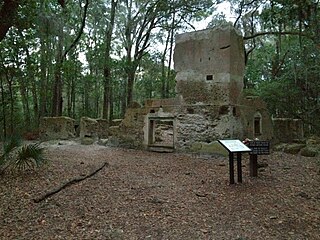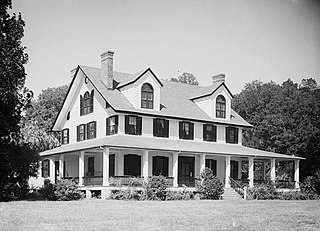Related Research Articles

Georgetown is the third oldest city in the U.S. state of South Carolina and the county seat of Georgetown County, in the Lowcountry. As of the 2010 census it had a population of 9,163. Located on Winyah Bay at the confluence of the Black, Great Pee Dee, Waccamaw, and Sampit rivers, Georgetown is the second largest seaport in South Carolina, handling over 960,000 tons of materials a year, while Charleston is the largest.

Murrells Inlet is an unincorporated area and census-designated place in Georgetown County, South Carolina, United States. The population was 7,547 at the 2010 census. It is about 13 miles south of Myrtle Beach, South Carolina and 21 miles north of Georgetown, the county seat.

Brookgreen Gardens is a sculpture garden and wildlife preserve, located just south of Murrells Inlet, in the U.S. state of South Carolina. The 9,100-acre (37 km2) property includes several themed gardens featuring American figurative sculptures, the Lowcountry Zoo, and trails through several ecosystems in nature reserves on the property. It was founded by Archer Milton Huntington, stepson of railroad magnate Collis Potter Huntington, and Anna Hyatt Huntington, his wife, to feature sculptures by Anna and her sister Harriet Randolph Hyatt Mayor, along with other American sculptors. Brookgreen Gardens was opened in 1932. It was developed on property of four former rice plantations, taking its name from the former Brookgreen Plantation, which dates to the antebellum period.

The Charles Pinckney National Historic Site is a unit of the United States National Park Service, preserving a portion of Charles Pinckney's Snee Farm plantation and country retreat. The site is located at 1254 Long Point Road, Mount Pleasant, South Carolina. Pinckney (1757-1824) was a member of a prominent political family in South Carolina. He fought in the American Revolutionary War, was held for a period as prisoner in the North, and returned to the state in 1783. Pinckney, a Founding Father of the United States, served as a delegate to the constitutional convention where he contributed to drafting the United States Constitution.

Mansfield Plantation is a well-preserved antebellum rice plantation, established in 1718 on the banks of the Black River in historic Georgetown County, South Carolina.

Roseland Plantation is a historic plantation complex site in Faunsdale, Alabama. The site is situated on a low hill at the end of a long driveway on the overgrown estate. It was added to the National Register of Historic Places on January 20, 1994, as a part of the Plantation Houses of the Alabama Canebrake and Their Associated Outbuildings Multiple Property Submission.
Joshua John Ward, of Georgetown County, South Carolina, is known as the largest American slaveholder, dubbed "the king of the rice planters".

Rebecca Brewton Motte (1737–1815) was a plantation owner in South Carolina and townhouse owner in its chief city of Charleston. She was known as a patriot in the American Revolution, supplying continental forces with food and supplies for five years. By the end of the war, she had become one of the wealthiest individuals in the state, having inherited property from both her older brother Miles Brewton, who was lost at sea in 1775, and her husband Jacob Motte, who died in 1780.

Plantation complexes were common on agricultural plantations in the Southern United States from the 17th into the 20th century. The complex included everything from the main residence down to the pens for livestock. Until the abolition of slavery, such plantations were generally self-sufficient settlements that relied on the forced labor of enslaved people.

The Chicora Wood Plantation is a former rice plantation in Georgetown County, South Carolina. The plantation itself was established sometime between 1732 and 1736 and the 1819 plantation house still exists today. In 1827, Robert Francis Withers Allston (1801–1864) resigned as surveyor-general of South Carolina to take over full-time management of Chicora Wood, which he had inherited from his father. Chicora Wood served as a home base for his network of rice plantations, which produced 840,000 pounds of rice in 1850 and 1,500,000 pounds by 1860. 401 slaves worked the plantation in 1850, increasing to 630 by 1860.

Stoney-Baynard Plantation on Hilton Head Island, SC was listed on the National Register of Historic Places in 1994. The listing included one contributing site on 6 acres (2.4 ha).

Friendfield Plantation is a 3,305-acre plantation near Georgetown, South Carolina composed of parts of six former historic plantations and Friendship House, built in 1931-36. It was listed on the National Register of Historic Places in 1996. Contributing elements of the listing include 23 buildings, 15 other structures, and 14 sites.

Sams Plantation Complex Tabby Ruins is a historic plantation complex and archaeological site located at Frogmore, Beaufort County, South Carolina. The site, possibly built upon and occupied well before 1783. It includes the ruins and/or archaeological remains of at least 12 tabby structures. They include the main plantation house, a rectangular enclosure consisting of tabby walls, a large tabby kitchen, and five tabby slave quarters. Also on the property were a variety of tabby dependencies including a barn/stable, a smoke house or blade house, a well/dairy house, and a well. The property also includes the Sams family cemetery and Episcopal chapel enclosed by high tabby walls. Other structures include possibly an overseer's house, a granary/mill, and a tabby cotton house. During and subsequent to the American Civil War the Sams Tabby Complex was occupied by freedman. Following the Civil War the plantation house was destroyed by hurricanes.

Annandale Plantation, originally known as Millbrook, is a historic plantation house located near Georgetown, in Georgetown County, South Carolina.
Keithfield Plantation is a historic rice plantation property and national historic district located near Georgetown, Georgetown County, South Carolina. The district encompasses 1 contributing building, 1 contributing site, and 3 contributing structures. They include a slave cabin, built about 1830, and agricultural features including examples of historic ricefields, canals, dikes, and trunks. The original main house burned in the mid-20th century. Keithfield was one of several productive rice plantations on the Black River.
Milldam Rice Mill and Rice Barn, also known as Kinloch Plantation, is a historic rice plantation property and national historic district located near Georgetown, Georgetown County, South Carolina. The district encompasses 1 contributing building, 1 contributing site, and 3 contributing structures. This rice mill and rice barn are associated with Milldam, one of several productive rice plantations on the Santee River. Agricultural features include examples of historic ricefields, including canals, dikes and trunks. The Rice Barn was destroyed by Hurricane Hugo in 1989.

Pee Dee River Rice Planters Historic District is a set of historic rice plantation properties and national historic district located near Georgetown, Georgetown County, South Carolina.
James Henry Ladson (1795–1868) was an American planter and businessman from Charleston, South Carolina. He was the owner of James H. Ladson & Co., a major Charleston firm that was active in the rice and cotton business, and owned over 200 slaves. He was also the Danish Consul in South Carolina, a director of the State Bank and held numerous other business, church and civic offices. James H. Ladson was a strong proponent of slavery and especially the use of religion to maintain discipline among the slaves. He and other members of the Charleston planter and merchant elite played a key role in launching the American Civil War. Among Ladson's descendants is Ursula von der Leyen, who briefly lived under the alias Rose Ladson.
References
- 1 2 "National Register Information System". National Register of Historic Places . National Park Service. July 9, 2010.
- ↑ Patricia A. Cridlebaugh and J. Tracy Power (September 1987). "Richmond Hill Plantation Archeological Sites" (pdf). National Register of Historic Places - Nomination and Inventory. Retrieved May 31, 2014.
- ↑ "Richmond Hill Plantation Archaeological Site, Georgetown County (Address Restricted)". National Register Properties in South Carolina. South Carolina Department of Archives and History. Retrieved May 31, 2014.

